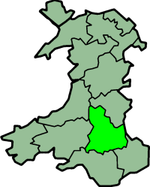Brecknockshire
| Traditional county of Brecknockshire | ||
|---|---|---|
|
|

|
|
| Capital | Brecon | |
| surface | 1,899 km² | |
| population | 55,544 (1961) | |
| Population density | 29 people / km² | |
Brecknockshire (Welsh: Sir Frycheiniog , also County of Brecknock , Breconshire or the County of Brecon ) is one of the thirteen traditional counties and a former administrative county of Wales . Brecknockshire has been largely owned by Powys since 1974 .
structure
The predominantly rural and mountainous Brecknockshire in the southern part of Wales is bordered by Cardiganshire and Carmarthenshire to the west, Glamorgan to the south, Monmouthshire and Herefordshire to the east and Radnorshire to the north-east . In 1961 the county had 55,544 inhabitants on 1899 km².
The mountainous area of the Brecon Beacons around the city of Brecon is only sparsely populated. Other important places besides the capital Brecon are Llanelli , Builth Wells , Crickhowell , Llanwrtyd Wells , Talgarth , Ystradgynlais and Hay-on-Wye , the book village on the border with England.
geography
The Black Mountains cover the southeast of the area and in the central region are the Brecon Beacons . Fforest Fawr is in the southwest of the region and Mynydd Eppynt in the north. The highest point is Pen-y-Fan ( 886 m ). Important rivers are the Wye and Usk .
History of the kingdom of Brycheiniog
The kingdom of Brycheiniog was established in the 5th century and survived until the 10th century when it was conquered by the Anglo-Saxons . During the Norman era it was classified as a lordship; the Lord of Brycheiniog was part of the Mortimer family, who ruled most of south and east Wales (called the Welsh Marches ). During the reign of Llywelyn ap Gruffydd over the Gwynedd he received the fief of a Lord of Brycheiniog, which was given to him by the King of England, Henry III by the Treaty of Montgomery (1267). The attack on Brycheiniog by the Marcher Lords Humphrey de Bohun and Roger Mortimer, 1st Baron Mortimer , in 1276 ended the peace between England and Wales; as a result, the rule of Llywelyn was limited to his country estate in Gwynedd. Brycheiniog was henceforth under the rule of the King of England.
The creation of Brecknockshire County
The Laws in Wales Acts (1535–1542) eventually created the County of Brecknock by amalgamating various estates into a Country or Dominion of Wales. The areas were "Brekenoke" ( Brecknock ), "Crekehowell" (Crickhowell), "Tretowre", "Penkelly", "Englisshe Talgarth", "Welsshe Talgarth", "Dynas", "The Haye" (Hay-on-Wye), "Glynebogh", "Broynlles", "Cantercely", "Llando Blaynllynby", "Estrodewe", "Buelthe" ( Builth ) and "Llangors". The city of Brecknock or Brecon was declared the capital.
The land was divided into six subdivisions ( Hundreds ): Builth, Crickhowell, Devynnock, Merthyr, Penkelly and Talgarth. Brecknock was the only place with city rights; Market places were Builth, Crickhowell and Hay-on-Wye.
The Local Government Act 1888 created an elected county council; the industrial towns in the south of the region ( Beaufort , Dukestown , Llechryd and Rassau ) were incorporated into the historic County of Monmouthshire. The county council met at Shire Hall in Brecon.
The Local Government Act 1972 incorporated Brecknockshire into the newly created County of Powys , where it became the Borough of Brecknock , one of the three districts of Powys along with Radnor and Montgomery . Portions of Penderyn and Vaynor were incorporated into the Cynon Valley and Merthyr Tydfil Districts of Mid Glamorgan , and the Brynmawr District and Parish of Llanelly became part of Blaenau Gwent .
In 1996 the Local Government (Wales) Act reorganized local governments. All districts were dissolved and Powys became a unitary authority with county status . In the 2001 census, the area of the former Brecknock district had 42,075 inhabitants.
Attractions
- Brecon Beacons and Brecon Beacons Mountains Center , Libanus
- Brecknock Museum , Brecon
- Dan-yr-Ogof Caves , Glyntawe
- Tretower Castle and Tretower Court
- Y Gaer, Brecon (Romanesque Fort)
Individual evidence
- ↑ rororo Duden-Lexikon 1966
- ↑ Population 2001 (PDF; 66 kB)
